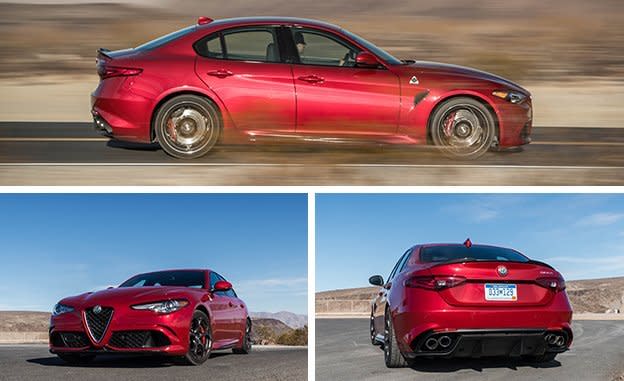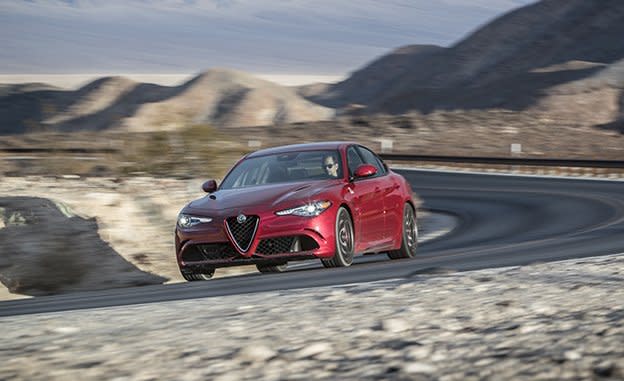2017 Alfa Romeo Giulia Quadrifoglio

Like a new fling, we don’t know where this is going or whether it’ll all blow up when we start meeting the rest of Alfa Romeo’s U.S.-bound family next year, but damn, things between us and the 2017 Giulia Quadrifoglio are hot right now. As in, cuffed-to-the-bedposts hot.
The sex appeal expected of an expensive, high-performance Italian car drips from the Giulia’s every curve. The Quadrifoglio upgrade piles on the pheromones with a snarling front bumper, a massive diffuser straddled by Ferrari-like exhaust tips, and a (painted) carbon-fiber hood and roof. The hardware also arouses. There is a torque-vectoring differential, the twin-turbocharged 2.9-liter V-6 has Ferrari lineage, and the available Pirelli P Zero Corsa Asimmetrico 2 tires and their ridiculously low 60 treadwear rating promise gut-shifting grip (and also incredibly brief intervals between replacements).

All of this adds up to a sports sedan that can really romp. With 505 cavalli at the ready, the Giulia’s horsepower advantage over the BMW M3, the Cadillac ATS-V, and the Mercedes-AMG C63 doesn’t go to waste, with 60 mph coming up in just 3.6 seconds. The quarter-mile flashes by in a blistering 11.9 seconds—both figures are class-leading—and although we didn’t have the space to verify it, Alfa claims the Giulia Quadrifoglio can achieve 191 mph. Those sticky Pirelli tires, in combination with the standard iron brake rotors (carbon-ceramic pieces are available for $5500), help the Alfa stop from 70 mph in a rib-bruising 143 feet. And we recorded 1.00 g of grip around our skidpad, a limit that’s gently approachable although so high that few will ever experience it on public roads.
Surely There’s a “But” Coming, Right?
You might think we’ve gone off the deep end, that the Alfa has tied one thigh-high around our eyes. You’re expecting us to come to our senses and realize that the Alfa’s wiles are only a distraction from the sort of flaws common to semi-exotic Italian cars. We must be excusing curiosities such as an odd or nonfunctional infotainment system, questionable build quality, or worse because we’re blinded by the sedan’s sparkling performance and looks. We couldn’t be more surprised to declare (for the most part) a great big “nope” to all that.
Truly, the strangest aspect of the Giulia is its lack of a folding rear seat or a trunk pass-through. The rest of the car’s execution is spot-on. The well-assembled interior resembles a Mazda 6’s businesslike environment, and the front seats are well bolstered and graciously accept the human form. Headroom in front and back is generous thanks to the attractively domed roof, although rear legroom is tight.

A trio of knobs on the center console are within easy reach of both front-seat occupants for command of the stereo volume, the DNA drive-mode selector (with Dynamic, Natural, Advanced Efficiency, and Race settings), and the dashboard display. The infotainment menu structure is commendably straightforward. Scroll to an on-screen selection and either press the knob or rock it to the right like a joystick to access submenus; tilt the knob to the left to intuitively back out of a menu. Simple. We only wish the plastic knobs felt more expensive and that either the screen was larger or that some of the generous unused display space were filled with larger text.
The controls that really matter are perfect. Facing the driver is a wonderfully thin-rimmed—yes, we said thin—steering wheel flanked by two column-mounted metal shift paddles so large that they resemble an old-fashioned horn ring accidentally installed backward. The paddles are always right where you expect them to be, and their size makes them easy to slap.
That delicate steering-wheel rim feels so right in the driver’s hands, particularly combined with the light effort that the helm requires and the lightning-quick turn-in reaction of the chassis. There is maturity to the steering as well. With an ultraquick 11.8:1 ratio, the steering rack easily could have made the Giulia twitchy and nervous in highway travel. Instead, the rack features a distinct on-center valley that allows for hands-off-the-wheel stability at speeds over 100 mph and rapid response to steering inputs beyond the valley without ever feeling abrupt. Restraint? In an Italian performance car?

The cohesive steering interface isn’t an isolated joy. There is a remarkable consistency of tuning among the suspension, throttle, and transmission. No one aspect overwhelms another—not a small feat considering the firepower under the hood—and this balance doesn’t change when switching among the four driving modes. Drive a BMW M3 with the throttle set to its lazy Efficiency setting back to back with it set to the jerky, meth-addled Sport+ mode, and it feels as if you’ve driven two different cars. In the Giulia, the throttle response is as immediate as your right foot can move even in the calmer settings, and the suspension never goes harsh, even with the drive-mode dial set to Race. In fact, regardless of the driving mode, the Quadrifoglio rides uncommonly well, and the aggressive tires never sing an intrusive thrum.
Full of character yet refined, the V-6 is a sweetheart. Despite its unbalanced crankshaft and 90-degree angle between cylinder banks, the V-6’s tingle at idle is no worse than the V-8 of a Chevrolet Camaro SS. A dual-mode exhaust is standard and fully opens during deep probes of the throttle; Race mode advances it to a wider opening even at idle. Those pipes emit borderline exotic noises when the tachometer needle swings toward the indicated 7000-rpm redline (fuel cutoff is at a high 7250 rpm), but they go comfortably serene on freeway cruises.
Although incredibly strong, the Alfa’s iron brakes avoid grabbiness, and, as befitting a proper sports machine, the brake pedal responds to increased pressure, not a longer stroke. Besides oddly requiring a little extra pressure to maintain consistent deceleration just before coming to a stop in normal driving conditions, the brake pedal reassures with abundant stopping power and smoothness.

We are declaring the Giulia Quadrifoglio the new benchmark among sports sedans. Yes, you read that correctly. It drives outstandingly well, and at $73,595 to start, it is priced in the thick of the segment. Our nearly loaded test car’s $79,195 as-tested price even counts as tame compared with the prices one can pay for an M3 or a C63.
Through Reality-Colored Glasses
If you were waiting for an asterisk, well, here it is: The 505-hp four-door, which is being joined by its less potent, 280-hp Giulia sibling in showrooms as you read this, is part of Alfa’s first crack at the mainstream U.S. car market since it fled from these shores 26 years ago. That breakup was definitely an “it’s you, not me” episode, given Alfa’s yellow-snow reputation for reliability woes, and there is no getting around the fits and starts that have plagued Alfa’s return to selling mainstream cars in the States.
We encountered a single snafu with our early-production Quadrifoglio: After remote-starting the engine one cold morning, the check-engine light flickered on and the driver information screen displayed a warning that the engine and the throttle-control unit needed service. The car was completely drivable and exhibited no strange behavior other than restricting us to what felt like the Advanced Efficiency driving mode. We cleared the ECU codes, and the problem disappeared. Such hiccups are, unfortunately, not at all rare industry-wide in this electronic age. Our long-term test of the current BMW M3 revealed numerous issues during its 40,000-mile stay, but we’ll need longer exposure to the Alfa to determine whether its systems are any more or less robust than the competition’s. Compared against the Alfa’s considerable excellence, the issue failed to cool our feelings.
But oh, boy, do we hope that this tryst lasts, because this thing is hot.
Specifications >
VEHICLE TYPE: front-engine, rear-wheel-drive, 5-passenger, 4-door sedan
PRICE AS TESTED: $79,195 (base price: $73,595)
ENGINE TYPE: twin-turbocharged and intercooled DOHC 24-valve V-6, aluminum block and heads, direct fuel injection
Displacement: 176 cu in, 2891 cc
Power: 505 hp @ 6500 rpm
Torque: 443 lb-ft @ 2500 rpm
TRANSMISSION: 8-speed automatic with manual shifting mode
DIMENSIONS:
Wheelbase: 111.0 in
Length: 182.6 in
Width: 73.7 in Height: 56.1 in
Passenger volume: 94 cu ft
Cargo volume: 13 cu ft
Curb weight: 3822 lb
C/D TEST RESULTS:
Zero to 60 mph: 3.6 sec
Zero to 100 mph: 8.1 sec
Zero to 130 mph: 13.8 sec
Zero to 150 mph: 19.9 sec
Rolling start, 5–60 mph: 4.2 sec
Top gear, 30–50 mph: 2.5 sec
Top gear, 50–70 mph: 2.8 sec
Standing ¼-mile: 11.9 sec @ 121 mph
Top speed (mfr’s est): 191 mph
Braking, 70–0 mph: 143 ft
Roadholding, 300-ft-dia skidpad: 1.00 g
FUEL ECONOMY:
EPA combined/city/highway driving: 20/17/24 mpg
C/D observed: 18 mpg

 Yahoo Autos
Yahoo Autos 